
Answer
378k+ views
Hint: In order to answer this problem let us get some idea about the Nucleophilic substitution. A nucleophilic aromatic substitution is an organic chemistry substitution reaction in which the nucleophile displaces a good leaving group on an aromatic ring, such as a halide.
Complete answer:

Let us understand this by an example:
A nucleophile (Nu) attacks an aromatic molecule that is electron-poor, resulting in the replacement of a leaving group.

The nucleophile's attack on the aromatic ring, which disturbs aromaticity, is the rate-determining step.
The aromatic ring's electron-withdrawing groups aid in stabilising the intermediate's negative charge.
Because the rate-determining step is not the loss of the leaving group, fluorine is frequently utilised as a leaving group due to its strong electronegativity.
The following are some common arene substitution reactions.
N-phenyl hydroxylamine rearranges to \[4 - aminophenols\] in the Bamberger reaction. Water is the nucleophile.
Diazonium salts react with halides in the Sandmeyer and Gattermann reactions.
The intramolecular variant of this process is the Smiles rearrangement.
However, nucleophilic aromatic substitution is not confined to arenes; it occurs much more frequently with heteroarenes. Because the negative charge is effectively delocalized at the nitrogen position, pyridines are especially reactive when substituted in the aromatic ortho or aromatic para positions.
The Chichibabin reaction (Aleksei Chichibabin,\[1914\]) is a classic reaction in which pyridine is reacted with an alkali-metal amide, such as sodium amide, to produce \[2 - aminopyridine{\text{ }}.\]
The meta nitro group is really displaced by fluorine using cesium fluoride in DMSO at \[120{\text{ }}^\circ C\] in the product methyl \[3 - nitropyridine - 4 - carboxylate.\]

Note:
All of the tendencies you learnt in electrophilic aromatic substitution (EAS) apply in nucleophilic aromatic substitution (NAS), but in reverse. The first thing to realise is that electron withdrawing groups (EWGs) greatly increase, not decrease, the pace of reaction.
Complete answer:

Let us understand this by an example:
A nucleophile (Nu) attacks an aromatic molecule that is electron-poor, resulting in the replacement of a leaving group.

The nucleophile's attack on the aromatic ring, which disturbs aromaticity, is the rate-determining step.
The aromatic ring's electron-withdrawing groups aid in stabilising the intermediate's negative charge.
Because the rate-determining step is not the loss of the leaving group, fluorine is frequently utilised as a leaving group due to its strong electronegativity.
The following are some common arene substitution reactions.
N-phenyl hydroxylamine rearranges to \[4 - aminophenols\] in the Bamberger reaction. Water is the nucleophile.
Diazonium salts react with halides in the Sandmeyer and Gattermann reactions.
The intramolecular variant of this process is the Smiles rearrangement.
However, nucleophilic aromatic substitution is not confined to arenes; it occurs much more frequently with heteroarenes. Because the negative charge is effectively delocalized at the nitrogen position, pyridines are especially reactive when substituted in the aromatic ortho or aromatic para positions.
The Chichibabin reaction (Aleksei Chichibabin,\[1914\]) is a classic reaction in which pyridine is reacted with an alkali-metal amide, such as sodium amide, to produce \[2 - aminopyridine{\text{ }}.\]
The meta nitro group is really displaced by fluorine using cesium fluoride in DMSO at \[120{\text{ }}^\circ C\] in the product methyl \[3 - nitropyridine - 4 - carboxylate.\]

Note:
All of the tendencies you learnt in electrophilic aromatic substitution (EAS) apply in nucleophilic aromatic substitution (NAS), but in reverse. The first thing to realise is that electron withdrawing groups (EWGs) greatly increase, not decrease, the pace of reaction.
Recently Updated Pages
Who among the following was the religious guru of class 7 social science CBSE

what is the correct chronological order of the following class 10 social science CBSE

Which of the following was not the actual cause for class 10 social science CBSE

Which of the following statements is not correct A class 10 social science CBSE

Which of the following leaders was not present in the class 10 social science CBSE

Garampani Sanctuary is located at A Diphu Assam B Gangtok class 10 social science CBSE

Trending doubts
Which are the Top 10 Largest Countries of the World?

Fill the blanks with the suitable prepositions 1 The class 9 english CBSE

How do you graph the function fx 4x class 9 maths CBSE

Give 10 examples for herbs , shrubs , climbers , creepers

Change the following sentences into negative and interrogative class 10 english CBSE

Difference between Prokaryotic cell and Eukaryotic class 11 biology CBSE

The Equation xxx + 2 is Satisfied when x is Equal to Class 10 Maths

Write a letter to the principal requesting him to grant class 10 english CBSE

What organs are located on the left side of your body class 11 biology CBSE




